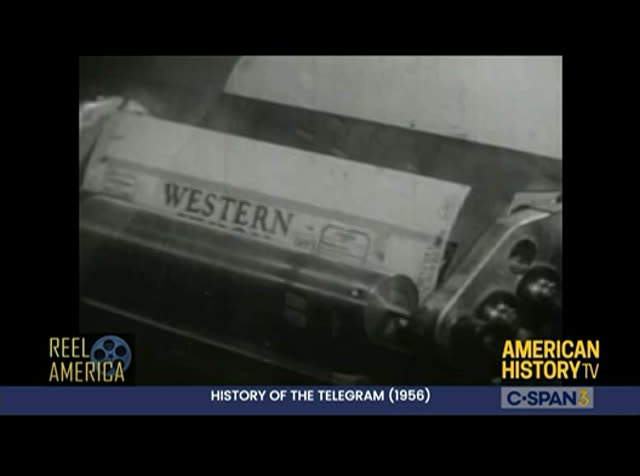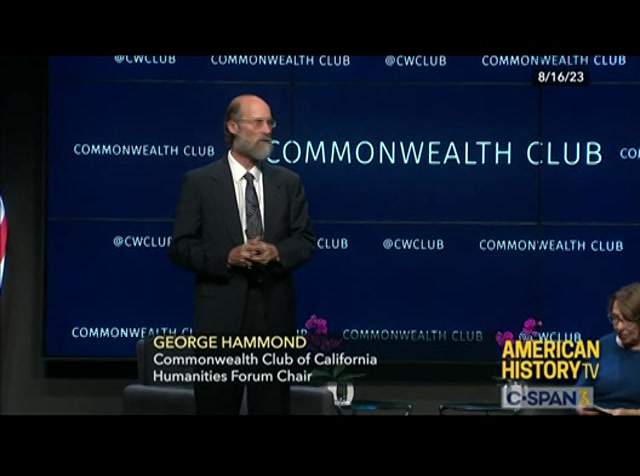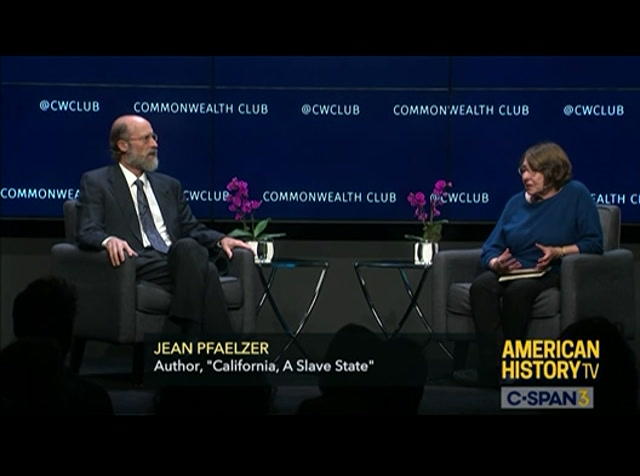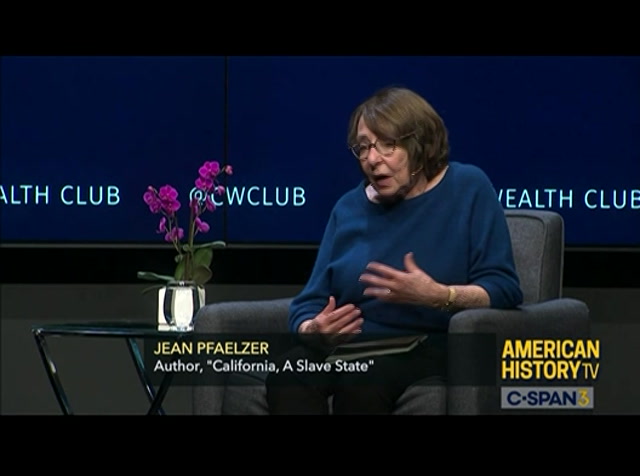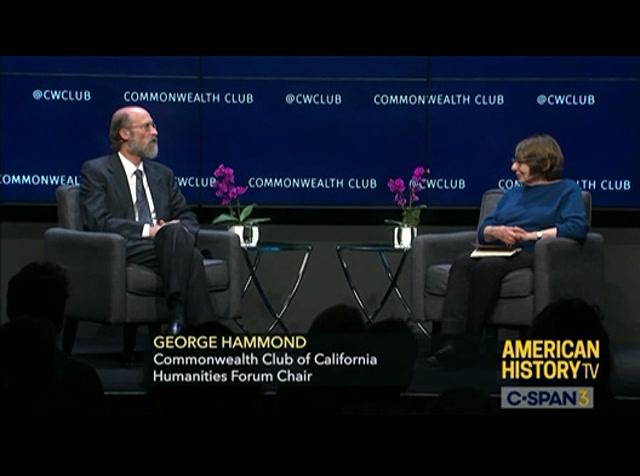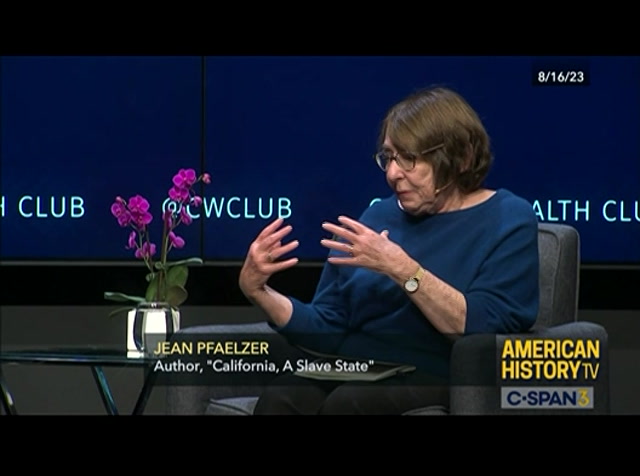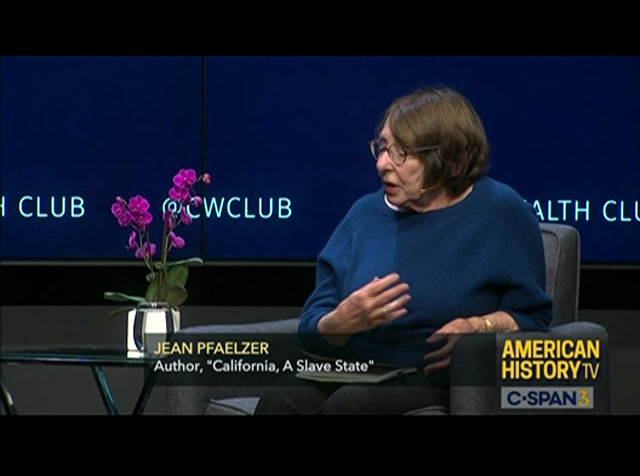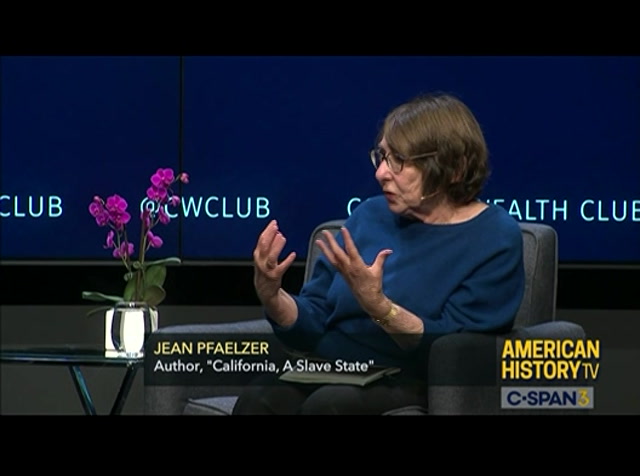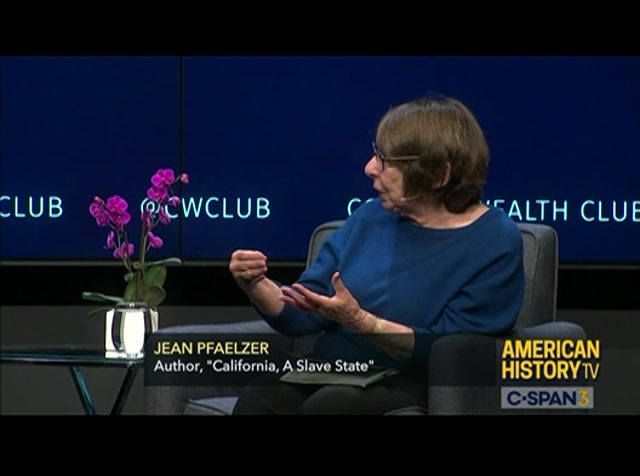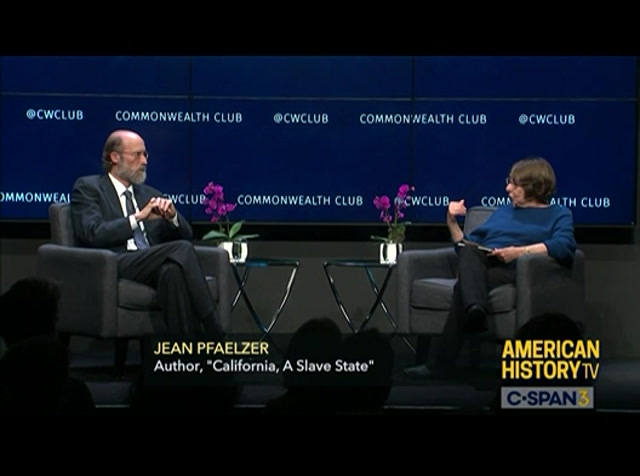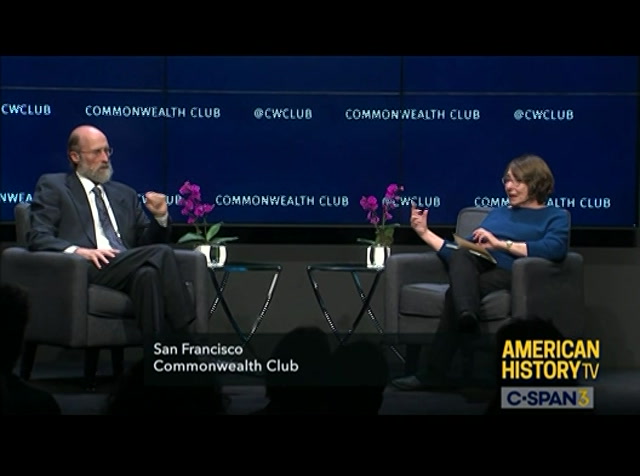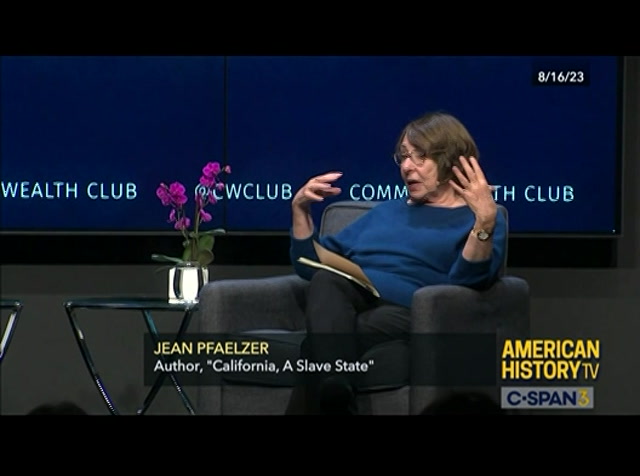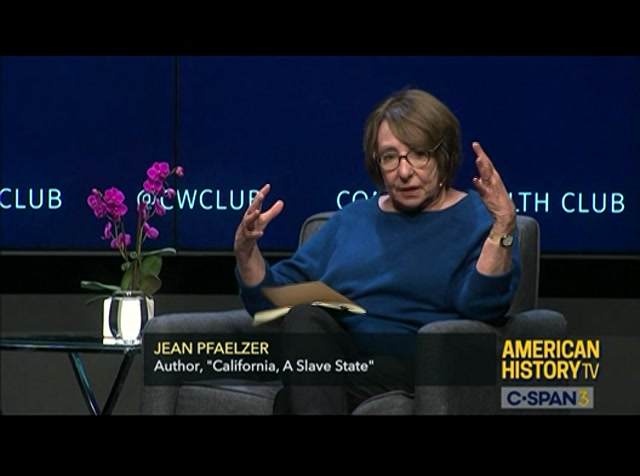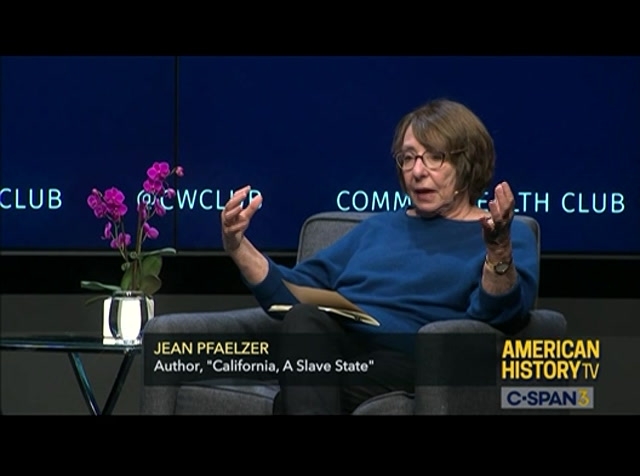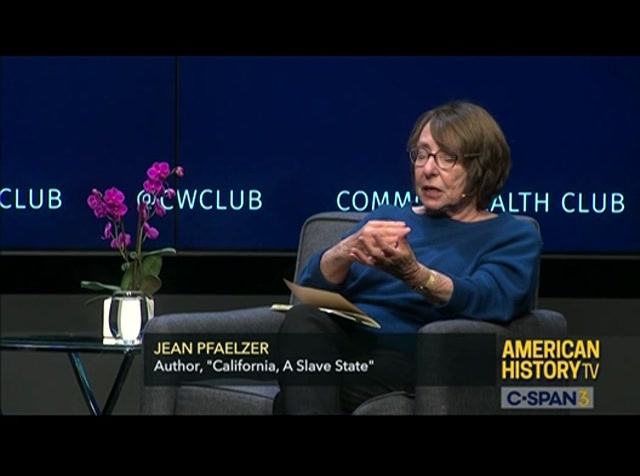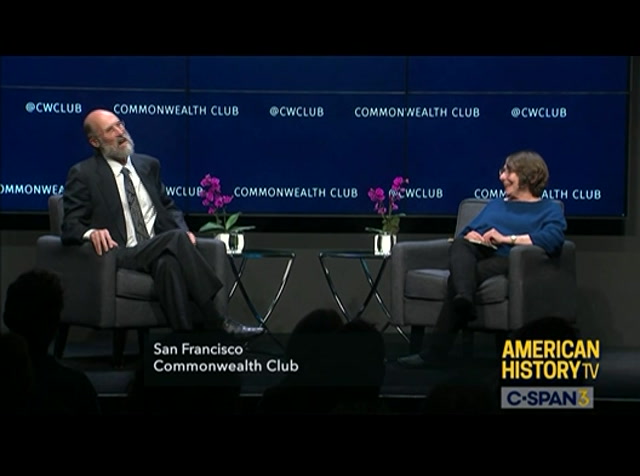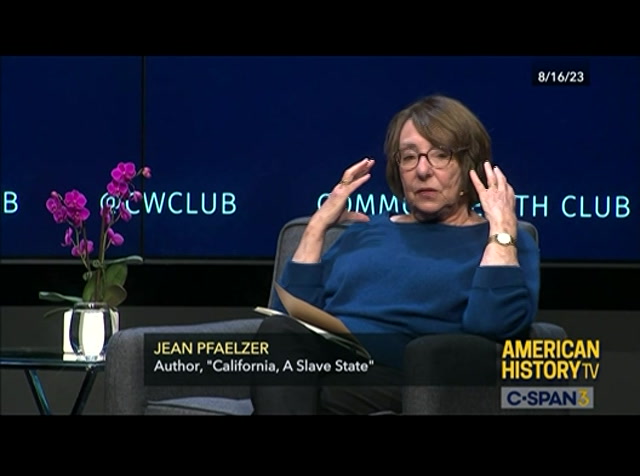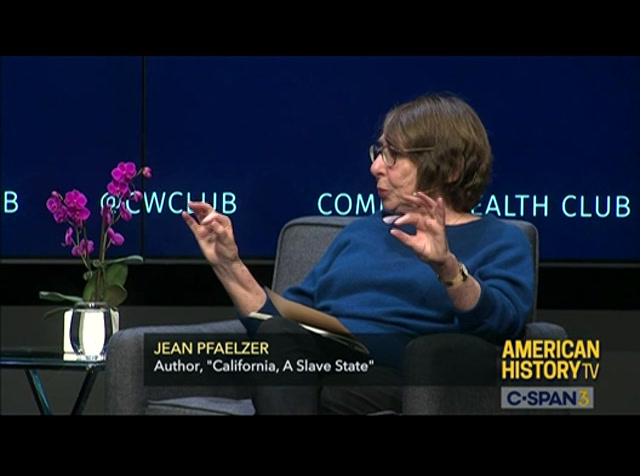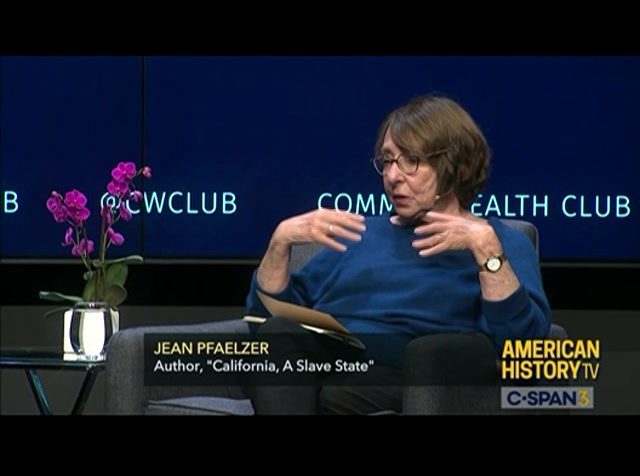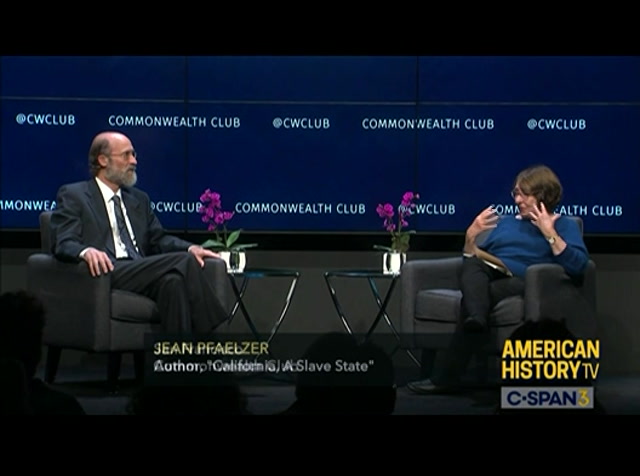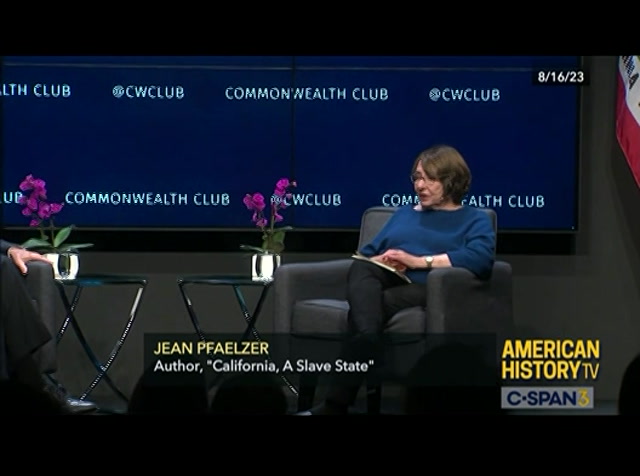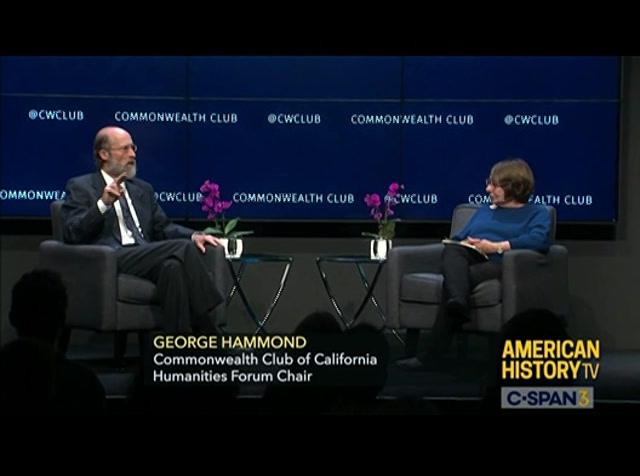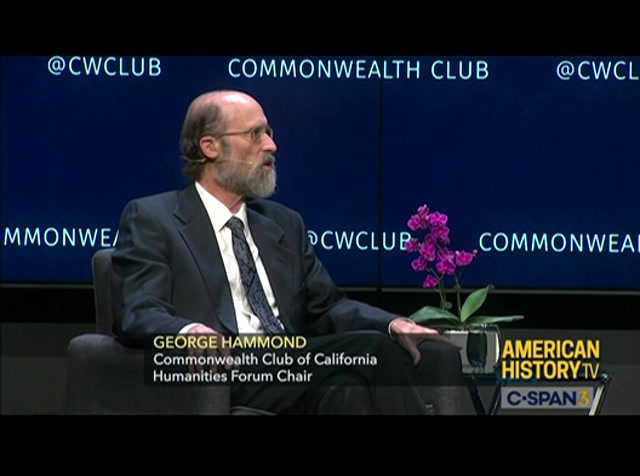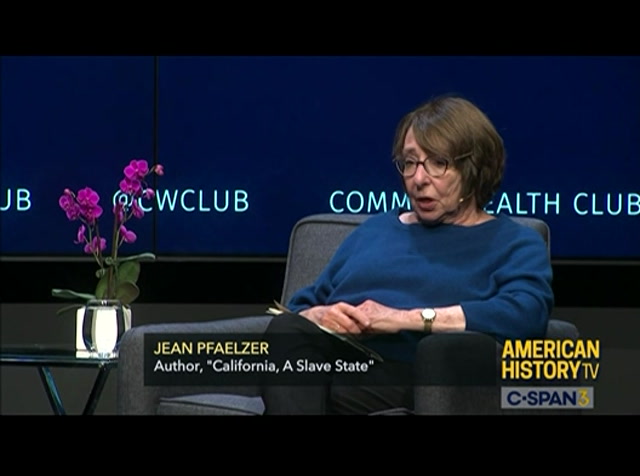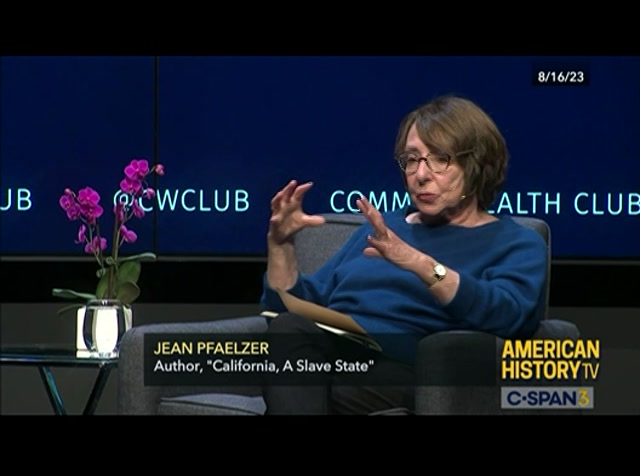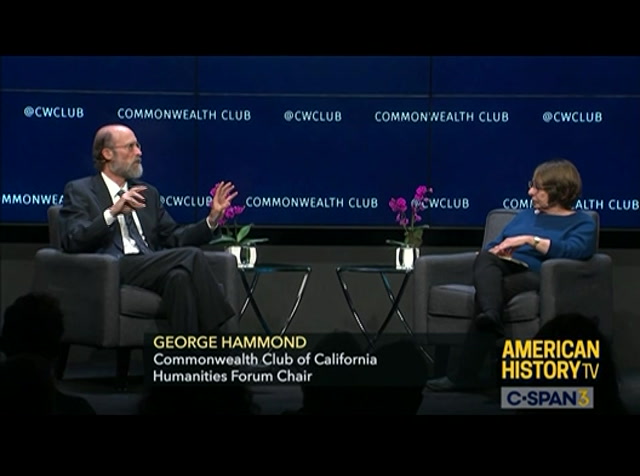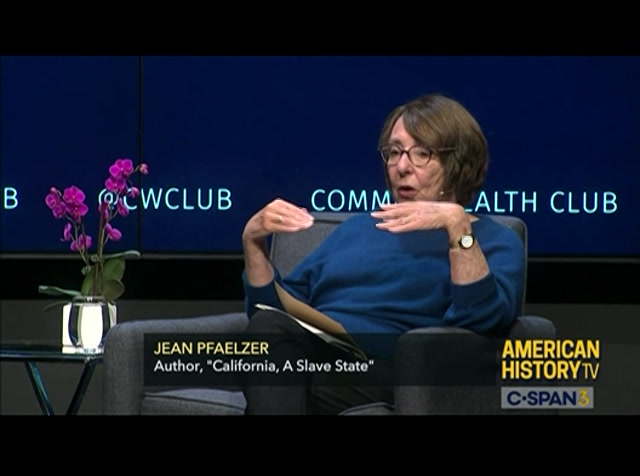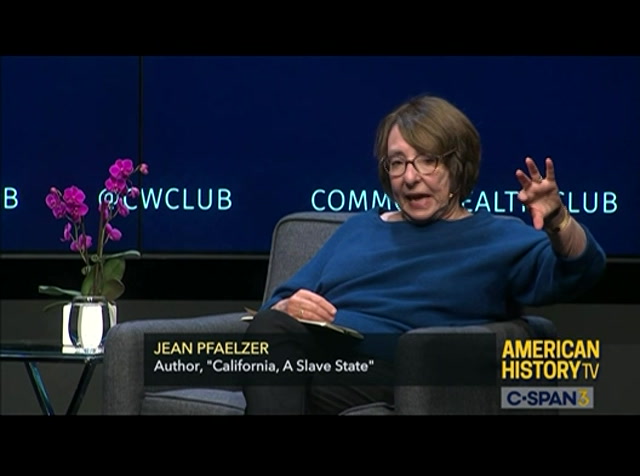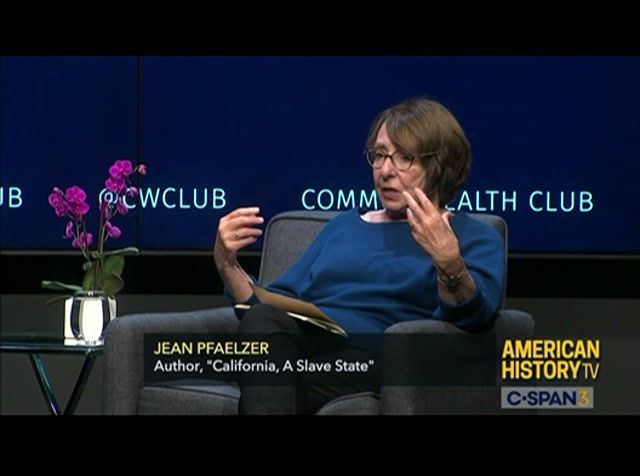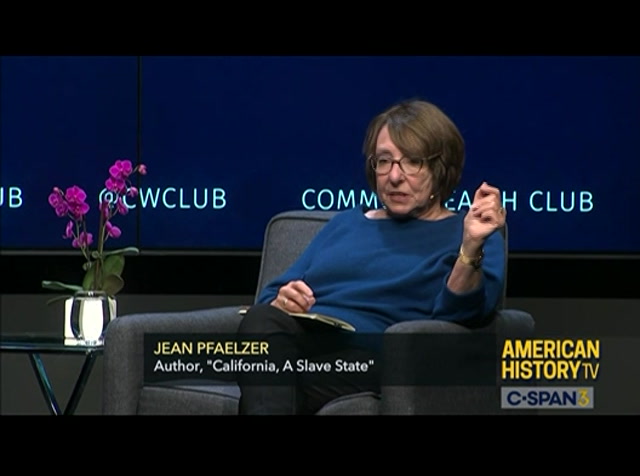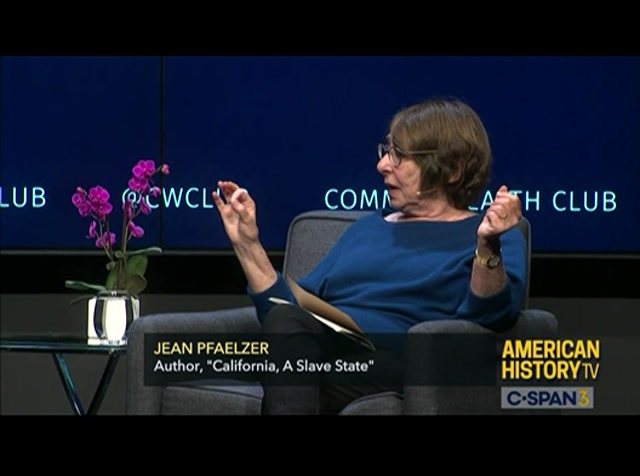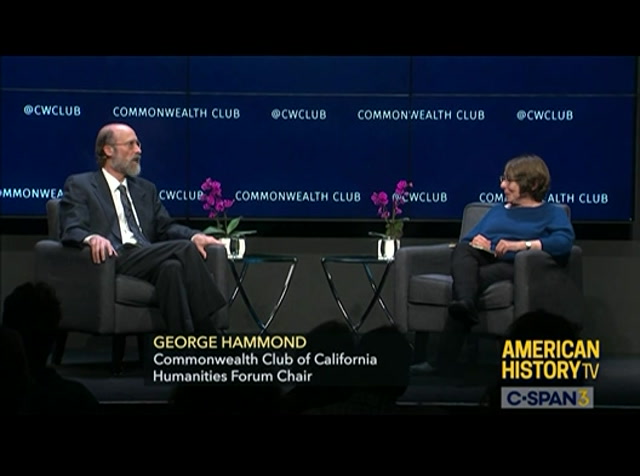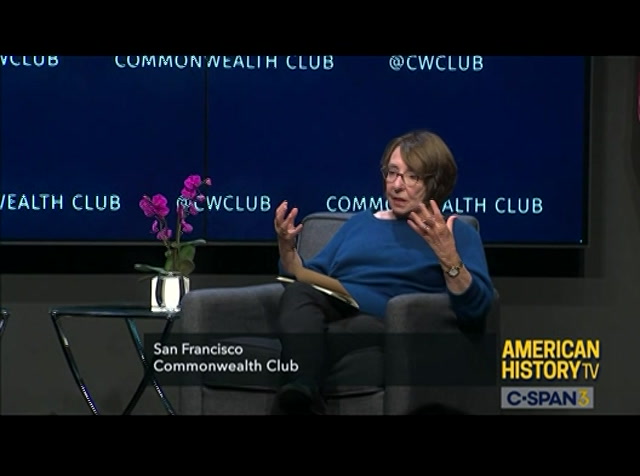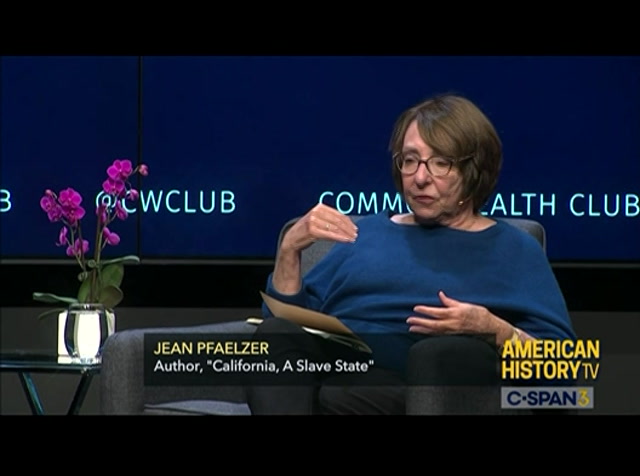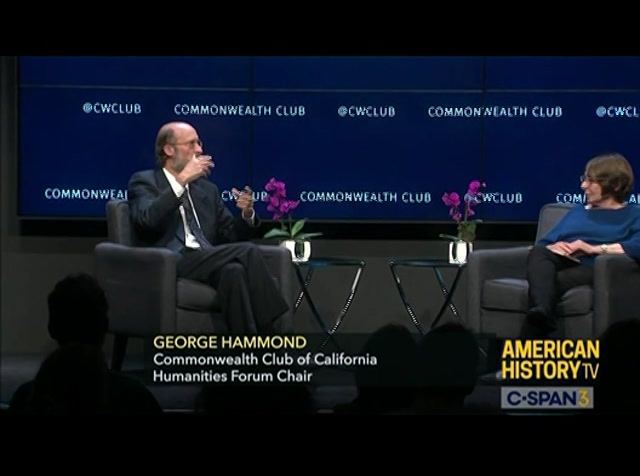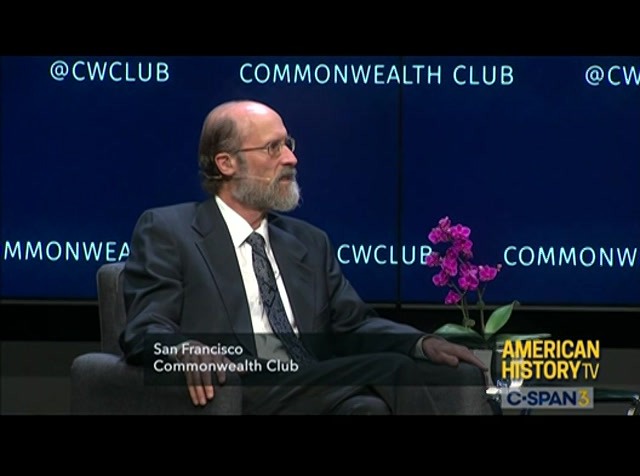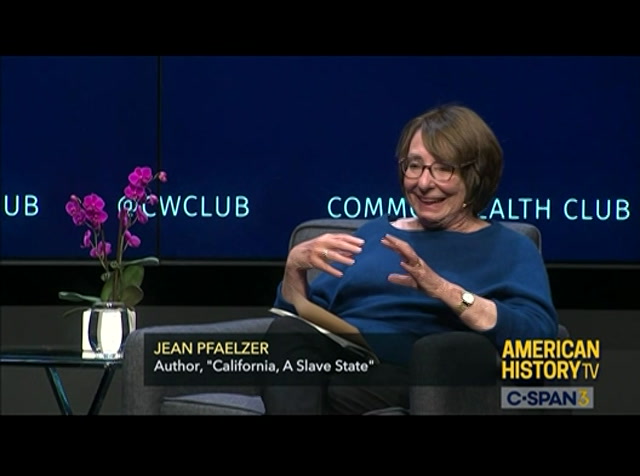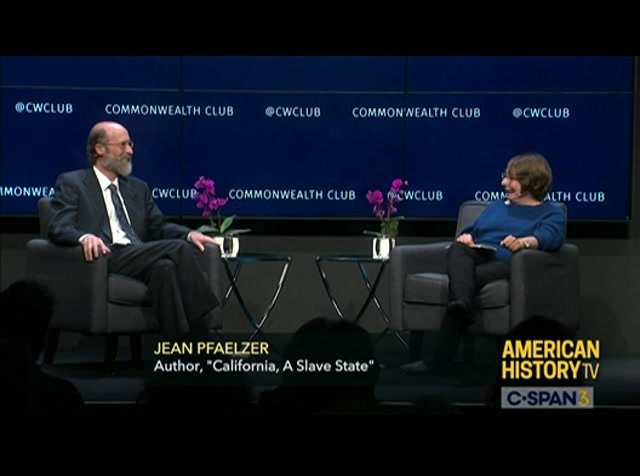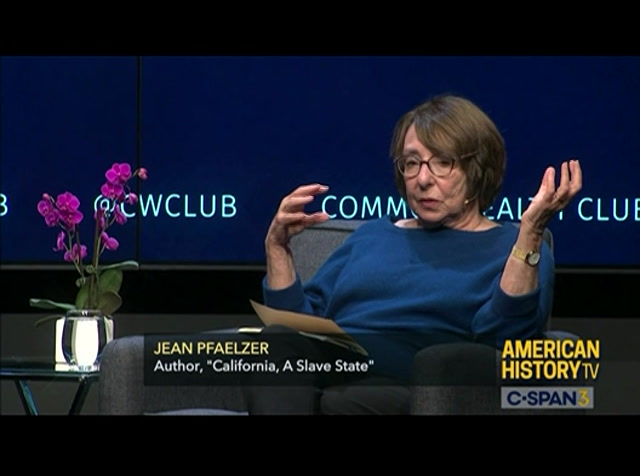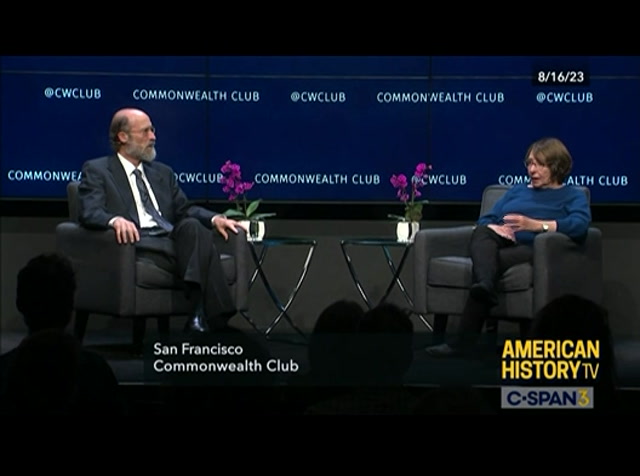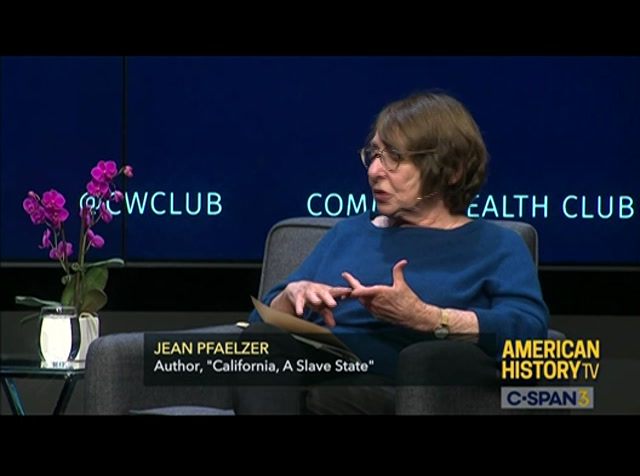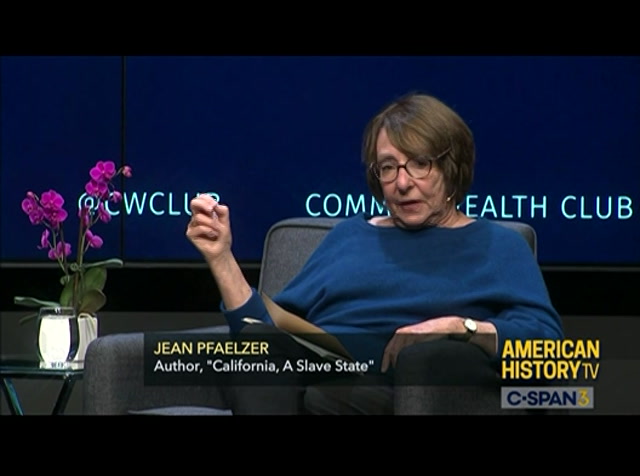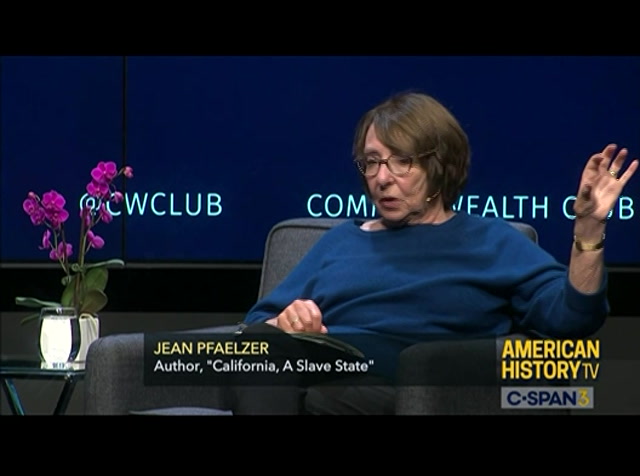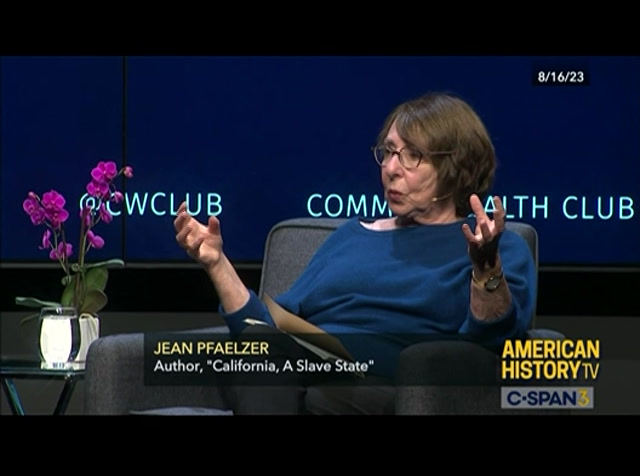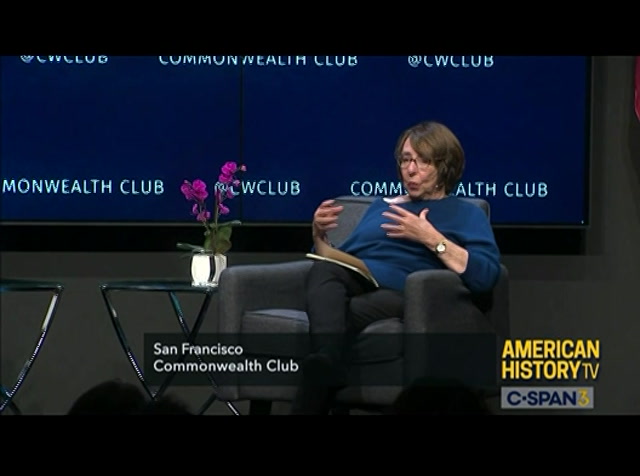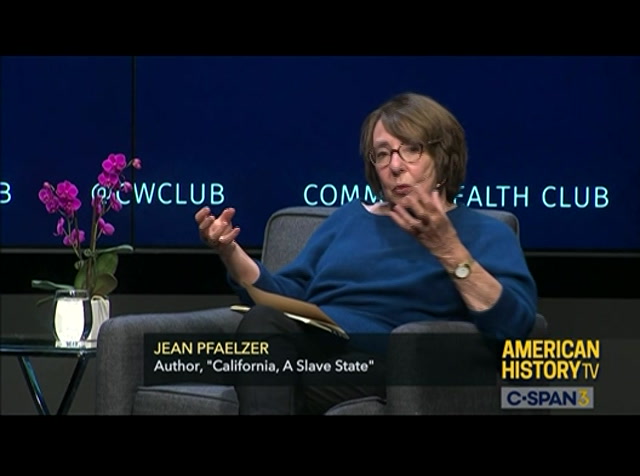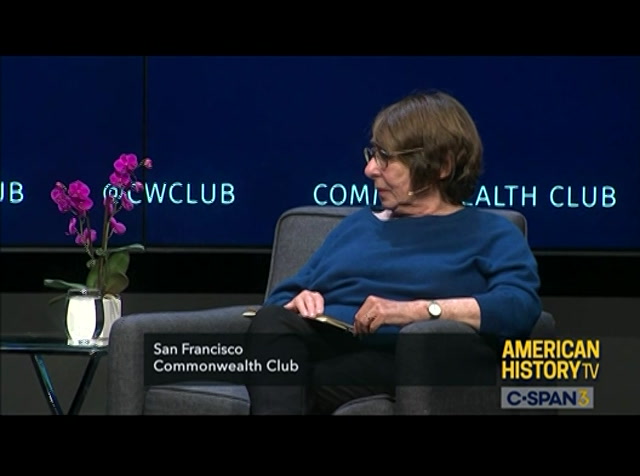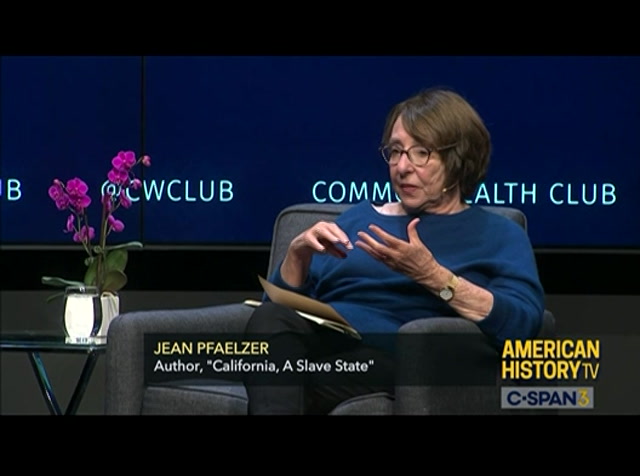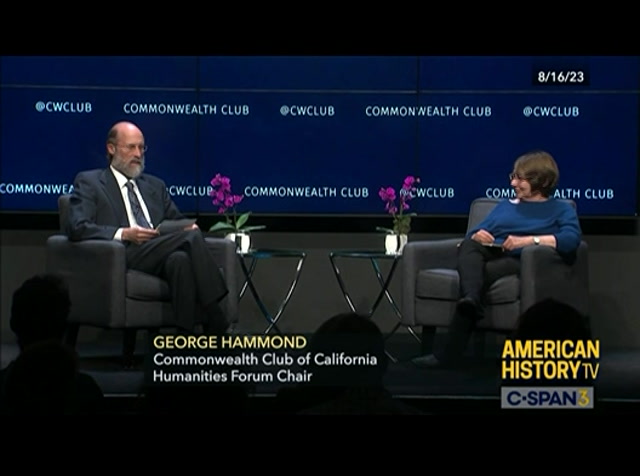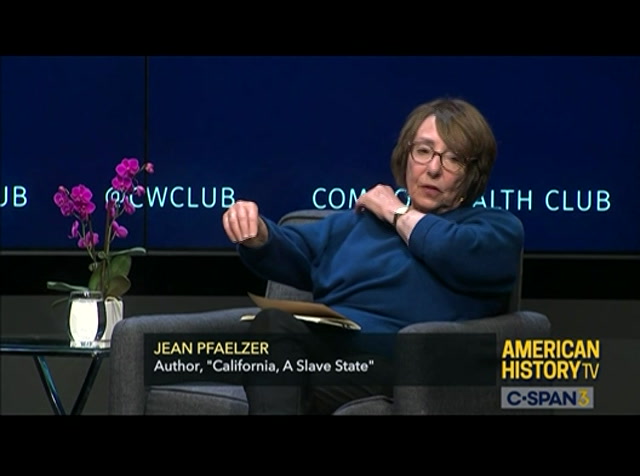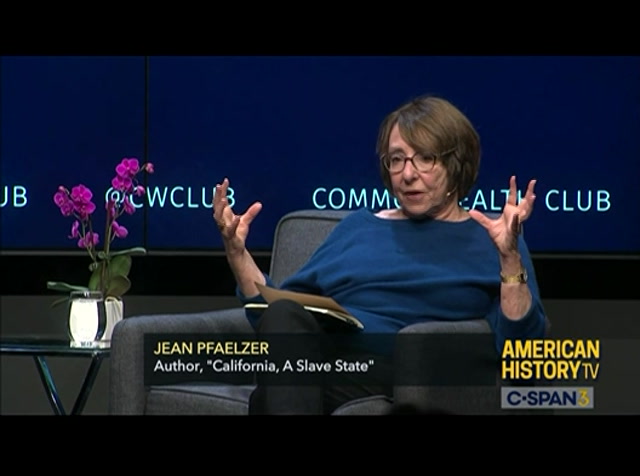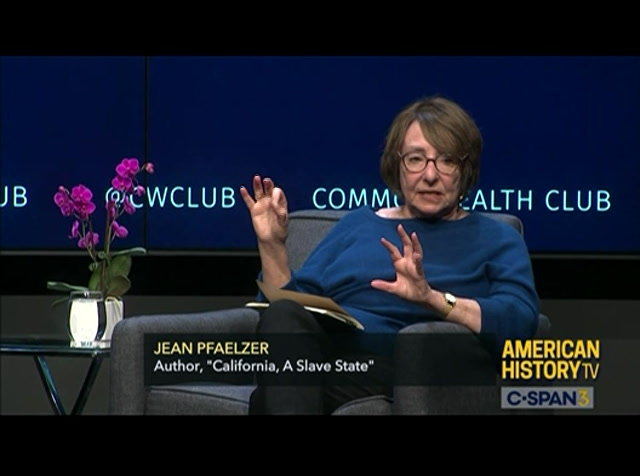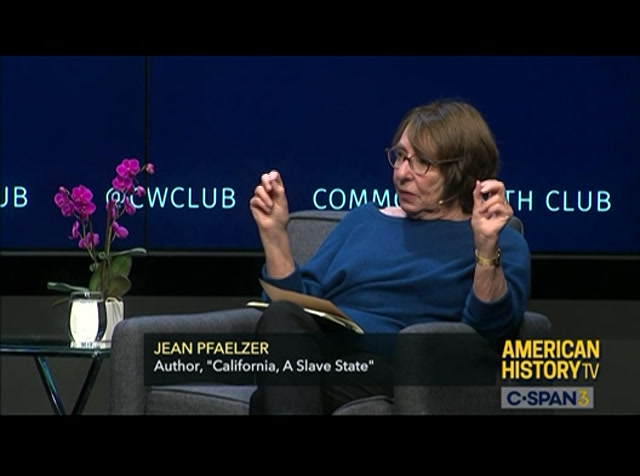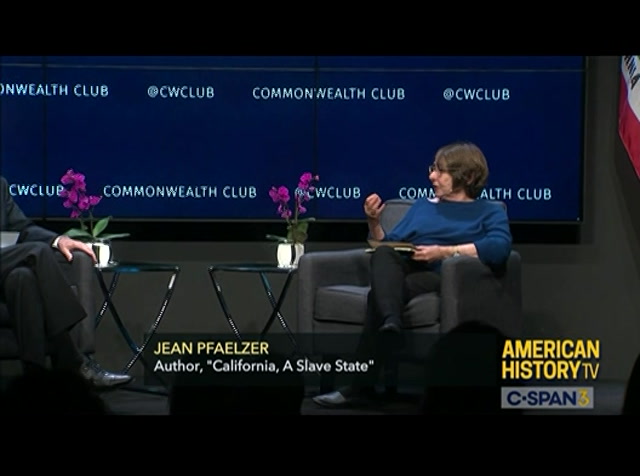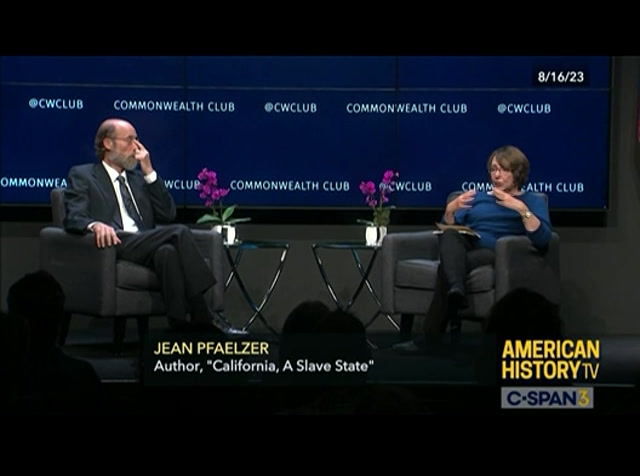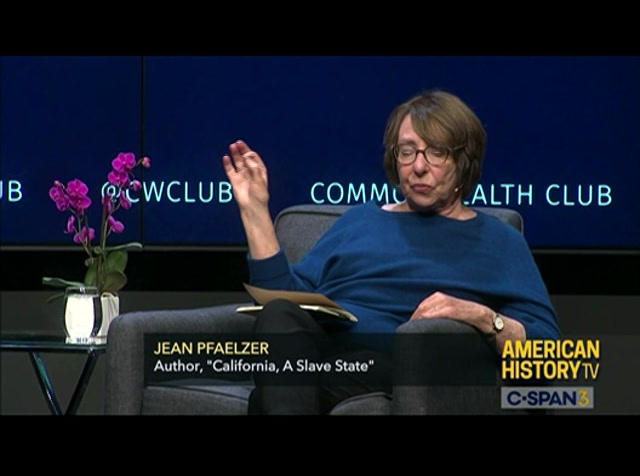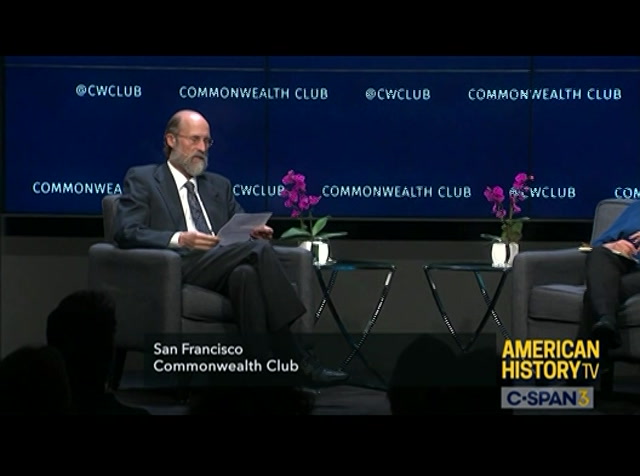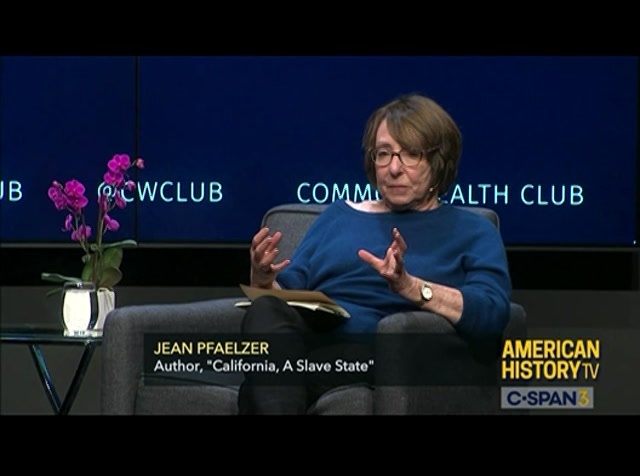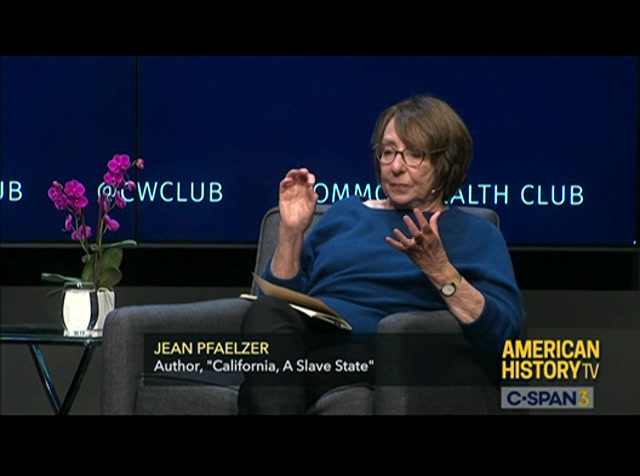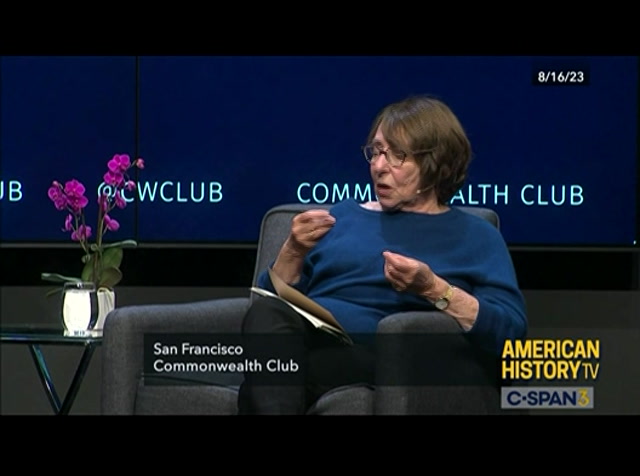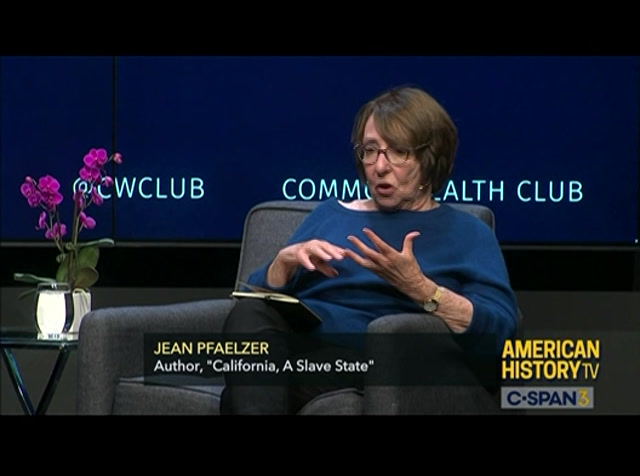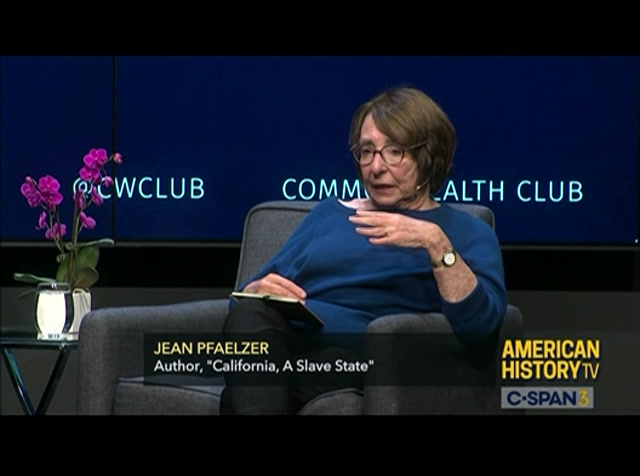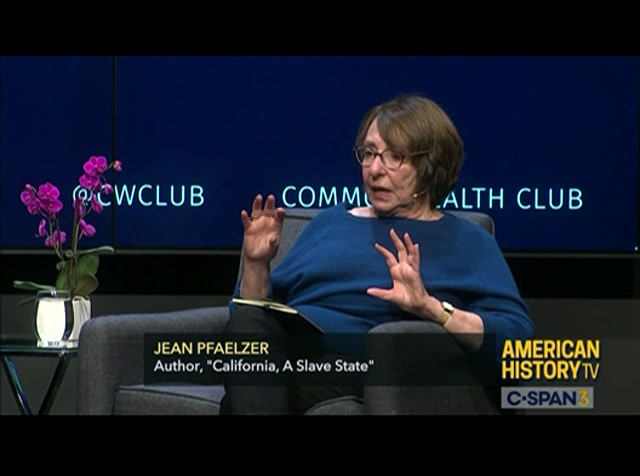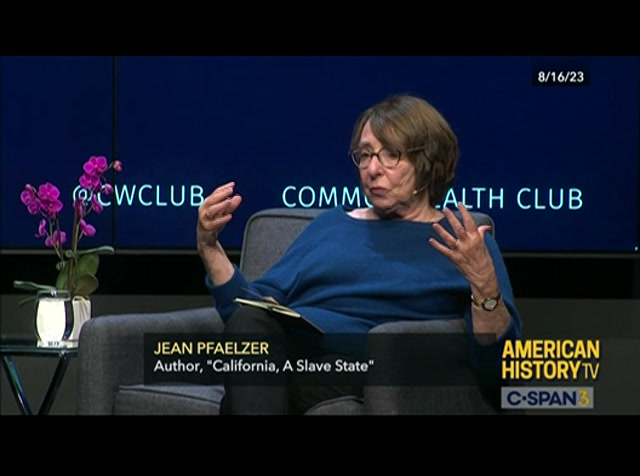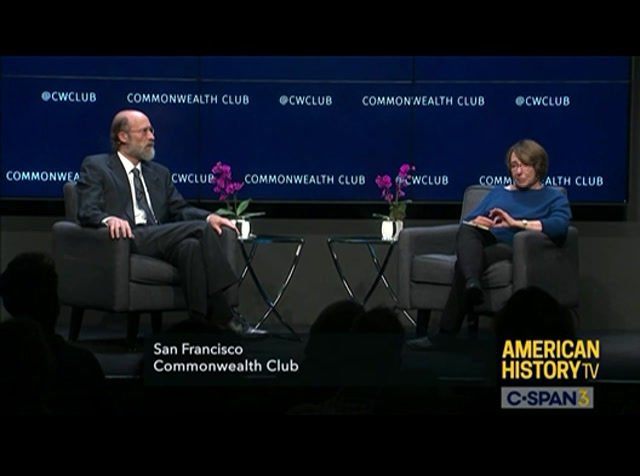tv Jean Pfaelzer California A Slave State CSPAN November 23, 2023 3:40pm-4:55pm EST
3:40 pm
new york comes a telegram. a telegram for america. one union is proud of its record through the first hundred years, a record of service and progress, which in the needs of today and plans for tomorrow, keeps pace with a tempo of fast moving age. today. we're going to talk about a very piece of california history which is not ignore ward, but certainly oveook it most of the time and so have jean
3:41 pm
pfaelzer here with a new book, califoia a slave state. and we' going to go through the history that i'm going to talk about the ideas behind it a little bit and also her rk on the reparation committee. so jeanie, thanks so much f for joining us at the commonwealth club. thank you. i'm glad to be back here. thank you so as iaid, let's start with history. so let's go back as far you into this history as we go weon't go all the way backo the native american tribes, but that's a good place tstop it. let's do terminologyirst. in your book, you use lots different terminologies. native americans native indians. how you make that choice. first of all, youse a lot of different. but i know that this is sort of a an important issue because a t of tribes, like certain names, don't like other names. and i thought, how d you make your academic about that? well, i think it's really important. start with the ia that california tribes did not have a
3:42 pm
history of slavery, that the was an occasional somebody who was a victor in a war who was taken, negotiated, but for the st part, especially all the coastal tribes, there just was not a long history of slavery as as think of it. so let's clear that one. yeah, that's right. one out right away. and in terms of talking about american people, lot of native american still use and prefer the word indian despite all of the history that think of when think of that term and i use word nativ american it was relevant i use the word such as the bazaar to act forhe government and protection of the dian which legalized t slavery of california native
3:43 pm
people. i tried to use the tribes names when they were avaable. a lot of this history is going on at same time as gecide in calirnia. many tribes were in flight and congress did not want to give land to california. native americans, and so they set up very f the very, very remote reservoir where tribes were blended together. so sometimest was just hard to find out who was where. the reservation and were't well guarded and people were transported under guard and en they fled. so tre was a lot of moveme of native americans around california during that time. and i just had nway often of knowing who i was talking in terms of tribal origin.
3:44 pm
and then i use t word native american, or when it would come up, i would use the word indian. sometimes i would use the word tribal people. great. so i just think it's important because it's hard. you cannot make every group happy using the terms becae everybody has their preferred term and i wanted your choices. i think it's important that the concern that we ha for respect for every group be expressed first and then this is how you have to decide in the book. so the the thousands of years of native american hiory here, california, that pceded this. well, start with the svery that came with the spanish. t the spanish missions got started a time where spain had alreadbeen had their empire for a long time, more than 100 years in south, in central america, before california new came along. so so why you tell maybe a couple of the stories of how the
3:45 pm
spanish decided um include you could talk about fathers sarah to to to come up to california and why they did it it was interesting the first slaves enslaved people were native americans who were enslaved by the franciscan missionaries they were enslaved by spain in the 18th cenry in 1769 two in a pair of sierra crosses the border of california right at san diego. he comes by ld. he was wound, determined to walk across the border. and he wounded with this seeping for from the the motr mission in laredo in baja, california. and he wks nor and.
3:46 pm
he meetsp with the contingent of reallit's tiny a hundred spanish soldiers and a fanatical cross the border at san diego and some come by sea the come i and epa people who are the local people in san diego are appalled at this invasionhere a little bit curious by the fancy gold crosses but mostly they're watching these especially the two ships keep unloading dead sailors. so this isn't a very impressive, atactive conversion moment. the spanish come though. so the soldiers were dead because of the terrors, the travel not not because they we assassinated. no, they weren't assassinated and died in route they died in route from disease and hunger
3:47 pm
and malnutrition and so the first thing thcome i see these dead bodies being unloaded from the ships not so persuasive. the spanish come under orders to expand the snish empire into california. they have two goals. the first goal is to stop the russians who are coming from the north. nothing i learned at hamilton high school in los angeles that the russians were in fact from the north. i thought the russian river was just a vacation or the bohemian club han out having been invited. they're not likely and so they're sposed to stop. the russians who a coming from the north, they are under a papal bull and order to convert california tribes to catholicism the spanish empire isn't very
3:48 pm
happy with the jesuits and they hand off the mission project to the francis winds. so the order is to occupy and to use the fertile land. the field of california to provide food for the native american people, the indigenous people whoave been captured and are to do the silver in mexico and, in peru. so they want to feed the people they want to extd. and mexico's sovereignt although they own land in from baja into alta, california, an stop the russians coming from the north. and so the plan is to set slave plantations to grow food. but also with this theory, logical sidebar, which is to convert all of the native american people along the coast
3:49 pm
of california to catholicism, well, we we have so much cruelty cover in just one hour that think the missions that is is one of the most we known pieces of this. but that was t start of institutionalized slavery in california. i think it's real important today to not only focus on the issue ofruelty that every single place there was svery in california, there were flights escape, space, crazy organized slave revolts that brought the mission system to end. we didn't learn this. our kids didn't learn about this. in the fouh grade mission project. but the kuma i people within a couple of years of sarah setting the mission in san diegond
3:50 pm
have entrapped kumari e pi people into the t kumari organized a revolt so this is why i just want to not talk about the volt because i was just in sacrento actually at, the california museum anthey have a nice one of the people that they're honoring is thai perennial toy perini corporation. yeah, well, tell her her story because that's that's a good one. all rit, there lotof ories. the kumari people sweep down om the mesas and coastline, the the kumari. i lived in small plan all over san diego county in what we now think of as baja california and, they organize a slave revolt and they plan it. they carve the arrows they make new bows and they down and they burn san diego mission. they killed the priest, padre jaime, and they free all of the
3:51 pm
kulmiye peop never to return. so this story with a slave revolt that i didn't know about toy farina was admissions and gabriel was panther in the valley in the valley north l.a. and troy perrine, a teenager. she's been designated as a shaman. she is totally stocked up on to lot. she t she's pretty much stoned out as far as i can tell. much of the time. and she's designated a shaman and she's urged lead a revolt at mission gabriel which mission you kn in what we now call the valley and a lot opeople are encouraging her to do this and she gathers the people tether
3:52 pm
and she's rabbit out and. so just as they're crossing the wall to free the people at mission san gabriel she's captured along with all the other rebels and she's sort one of my heines because when they capture her they want her to testify and they give her a little witness stool and they she says, i will not sit on your stool. and she stands during testimony and chars them with the captivity of her people. d she's sent to one of the presidio, the presidio four forts or jails. she sent to one of the presidio is forever. she's banned from her people and her river vault fails. other volts succeed. what i also didn't know thinking
3:53 pm
abt the fourth grade mission project is that there is an organized slave revolt at mission santa barbara. santa ynez mission semper ma, and they take over the missions and all of the native people who are captured with those flee into the tully's and they escape there chased by the mexican military. to this int, california's owned by mexico. they escape into the tully's and the military military chases them the horses can't make it the tully marshes and they finally roll through with a cannon and blasthe people open. many were slaughtered. some are forced to return, and st of them into the tully marshes. so the slave revolts go mission by mission. mission, whether it'the kulmiye or the tongva and they
3:54 pm
bring down the missn system. what brings downhe mission system is that mexico wantshis land. they don't care about the mission system. right? once mexico takes over from spain, yeah. when they get there. yeah. so a series of forces come together to bring the missions. then the question is, what's mexico going to do with all of this land? and i found these incredible where the tribal people at the differt missions demand the land that they have been ford to turn from their land to mission land and they mand their land back. they demand compensation. they demand freedom, and they actually demand the right to vote, ich they don't get. the type of story, if she had only been bued at the stake, you know, it would havbeen joan of arc all again. you know, that's rely weird.
3:55 pm
but very similar story. uh huh. oh, okay. i mean, topiary ned never saw herself as a martyr, right you know, she really sawerself as a leader and charisma, attic and divine a spiritual leader. a shame, a leader of her people. and she didn'to lose. they didn't fire it out quite perftly. no, i'm sure joan wanted to into. so let's cover russians because that's thpart that lot of people don't understand and thought one of your statistics was fantastic which was that one sixth of the rsian and russian government expenditures in the year went to trying to set up this trade in otter pelts and and and the other one that was fascinating was how an outer pelt sold in beijing and that this was of their thing. so why don't why don't you tell what motivated the russiancome in? because it wasn't the same
3:56 pm
motive at all. the spanish totally different it was not land. and it wasn't god. right. they wanteotter pelt otter. well, mean, we think of otter pelts are really otters are really ce, you know, and they lie on their back and, you know crack crabs. but they also have a million hares per square ih. it is the softest, silky r in the world. and we look at pictures w of the chinese mandarin class and we see these huge fur collars and muffs and rings around their robes that fur for the most part, and lot of it came from california. the russians have crossed the bering strait. they're thinking they're going to find a route to. china, justhe eternal route, china and they don't find it beng is shipwrecked on a rock. bering dies and spends this
3:57 pm
horrible wel he's dead. but his peoplehis sailors spend this horrible winter on the cks and as the ice melts, they find otter fur and they rebuild eir broken ship. the ice doesn't melt till may and they take it bac to russia and they delivero the emperor a thousand otter pelts. and the pelts were selling in the currency of the time for $3,500 propelled and they've taken back a thousand of these pelts and they call it soft go and this is going to save the broken russian empire. so no route to china but a route to increase wealth and prosperity and to make it work. russia create the russian-american company. and in the charter it says that the russian fur are allowed to
3:58 pm
enslave. 50% of the alaska native men, the alaskan native in their kayaks are the only who are really skillful enough to kill the otter. so there's a different slave triangle of alaska, california, canton that grows out of that when i went to berkey, we would go to fort ross and we take a bottle of wine, eat the little russian cookies and the little girls with the aprons, the buer cookies. i had no idea that fort ross was a slave plantation and that's where russia bases this trade out of. they're scared of the spanish so they deposit the otter hunters on the farallon island and they abandon them for six mths and. an american actually boston whaling ship sailed by pick up
3:59 pm
e pelts leave a bag of flour and told to survive. and they're guarded by a russian. there are also native women who are creating these skin kayaks and increase edible waterproof clothing. ari, i have nothing on them. they are out of the gut of the usually. of the sea lion. mm hmm. totally. clothing and those the women. so. and ey oil and stitch the kayaks. hmm. thalaska nives paddle up what you call the river. now we call the russian river now. they were scared to go she because that's where the spanish were. mm hmm. so. and also, those of you who've spent time on the rather smelly farallon islands, they're surrounded by. so it wasn't an easy escape for
4:00 pm
the alaskan native people. and they're far from home. it was azing how cavalier they were about using these people. and then just leavinthem, you know, just like they even even in their own self-interest. it would seem that they would have taken slightly better care of them. i think self interest and the economics of enslavement don't necessarily really mean to treat these working well ever. certainly doesn't seem that way. i mean part of the definition of slavery involves forced mobility, vience rape, constriction srvation, fear, threats about the people still at home. so it's not a labor that tends to be treated with respect. right. and the question for the question for me is for yous that that's been going on for all of human in lots and lots
4:01 pm
places, most times not quite as bad as some of the stuff we've had. but still very bad. do you have any idea, having studied this so thoroughly why we are so cruel to somebody else? why would we do that? no, no, no answer. okay. i i've lived with this book for almost eight years wh time for some life, for covered. and at the end of it and maybe it's my optimistic that i got from my dad, my politics. i don't have i don't know of any body here. have an explanation for human and brutality. i can say that it was about profit. it was about conquest of land. it was about. it was about power. but at the end of the day, i
4:02 pm
don't know. i truly do know how i wrote ts book. and i don't. an explanation for human evil. it's interesting that some of the other things that you mentioned, so i'm going to jump time frame for just a second here to 1850s in san fncisco and you mentioned that the murder rate for the first six years after the gold rush in francisco, the 1200 people were murdered in those six years in that town. and it seems to me i don't have the exact statistics, but maybe the average number of people in the town, 25,000 during those six years. that would be a murder rate of of 800 per 100,000 people. right now our, murder rate is 6.9 per 100,000 people and st louis, is that about 65 or something like that, which is the highest the united states and the murder rate in san
4:03 pm
francisco was 800 per. so it's 100 times worse than it is now and it was an all male society as we know are in almost all male society and it wasn't exactly the highly educated that came. i mean, certainly some. but it was it was the rough crowd and this rough crowd, um, i think it has do with something in psychology that if you feel that you're at the dregs, that you have to make somebody else feel than you are so that you can, you're on top of them. something. it was i mean, the gold rush brougha lot of greed, a lot of violence, a lot of petty crime, a loaf of bread was selling for $18 for a loaf of bread. people were starving. so and people we violent. and this aura of gold brought, people from all over the world
4:04 pm
the news of gold traveled the pacific rim vy quickly. it was easier to get here in san francisco from china or from chile or argentina, where there were gold miners, a tradition of gold mining. it was easier get here from latin and south america and asia than it was to either the plains or cross through the jungles of panama to come here to mine. so it was a highly male, but would have to leave out all of the native american women who were here and the chinese girls who were kidnaped fr the port cities of guangdong, canton, and brought as enslaved prostitutes to service this very what was called than a bachelor town or a bachelor community.
4:05 pm
so it was a violent, greedy town, but it wasn't. , i wouldn't construct all of the gold miners as, quote, the dregs society. we know. well, i didn't know. no no. now that plantation owners crossed the pins or through the jungles of panama a very wealthy plantation owners, brging with them two, three or four enslaved african-amecan men who walked across the plains or who carried their owners uipment and gambling tents and mining equipment through the jungles of pana up one side, the chicago river dn the other, and on the other side, with thousands of miners competing little ships to bring up to san francisco and tn to go on to sacramento, whi was
4:06 pm
the base for the gold rush. so there were very wealthy people andeople are making making profi off the gold rush and off enslaved people to do the really nasty work standing up to here, younow, in the mud, looking for well, the gold nuggets went very fast. they're looking for little sliver of ttle slivers gold dust, which is nasty dirty, cold, muddy. a lot of the plantation when they get here, realize they're not up for it. hmm. and they want to go back? yeah. it was a fascinating part. not only thaelement of bringing slaves with them, but of the politics of early california was that there was such a large number of southern plantation owners. did you come across anything that showed it was an intention attempto send some people
4:07 pm
from, the south, in order to try to influence the dision about whether california would be a slave state or becausehis was before the missouri compromise, s and i know that peoplead sent from the south to missouri to try to influence the the vote there and other places. so was california a part of that. was it intentional or was it just tt the goal grabbed people's attention? well, i thk gold was huge in as a magnet of bringing people to california. it was men. they wanted adventure they wanted to get ay from home. the u.s. had just won in 1848, the war against mexico. and we havwe the united states have lopped off and taken the top of mexico, some nuers there. 55% of mexico. alof a sudden in 1848 becomes american a the issue is, what do we do with it? and the pressure is on with gold
4:08 pm
to get calif in to quickly into the united states. california is sending back in the money of the time $1.2 billion of gold back to the banks. the insurance company the shipping companies in the east coast. so this 1411 free state one slave state will enter in a paired wayhat's done because there's no state to pare with california. there is this thing. it isn't ever even legally a territory out west. that quickly has to become a state and plantation owners have always the have always wanted to go west. mm hmm. and part of the pressure for the mexican-american war, the war against mexico, is to grab as much territory as they can and
4:09 pm
turn it into areas slavery could thrive. mainly, people were thinking tobacco and cotton. tobacco and cotton are horrible for the land and the land in the south was in bad shape. the solution was just expand slavery to the west. it it expands very into texas right away. there are 200,000 enslaved lived african-americans in texas, very quickly. in fact, some of the plantation ners don't even bother to bring slaves from their own plantation with them. they're just going to buy them and route to california and go through northern texas and take them off of e cotton. one of the stories you told that was very interesting was a small story, but it was a revolt of free blacks in california in the 1850s that that thought that they were going to be free here
4:10 pm
and didn't work out that way. and a whole group of them moved british columbia, which reminded of how a large number free blacks in new orleans moved to mexico, central america at the same time. and that part of the story is, isn't very often either that that america was such an awful to live that people were leaving to go to other countries in order to avoid the the serious issue. yeah. in in the 1850s free black from. in the 1853 blacks wanted to come to california f the gold rush just like everybody else they wanted the money, the adventure. but what free black people in the northeast were facing was the fugitive slave law. so in addition to all of the white men were coming west, there was this real pressure to
4:11 pm
get away from the fugiti slave law, which pretty much made it available all for white people to ensnare any black they saw. and sell them, sl them or transport them. south. so, frederick douglass, the great abolitionist, says to his community of, free black people don't go, you know, we're in the midst the height of abolitionist movement. it betray our cause. freedom for you to leave now. and they say, douglass, we're out of here. we have the same right as every other person to access to this wealth. and we got to get out of here because of the fugitive law. douglass says to them. okay. and he picks a few of them include. one of the men import figure in
4:12 pm
california history, mifflin, worcester, gibbs. he says. gibbs okay, you can go with my blessing, but travel with me for a summer. so that you learn how to be an organizer and an order and. they see it all. they see the burned churches. they see the vionce. and gibbs comes out here and becomes one of the leaders o free black people in calif. and he meets up with her free black people who have come ou here to they don't expect to find enslaved blacks in california. they do not expect to find slaved black in california, in the mines or in the streets of san francis. and it's the constitution was against it. well sort oft's dicey because california is quickly writes a constitution. so it can join the uted states
4:13 pm
and it's supposed to enter as a free state. that's the deal. but it writes into the constitution slavery will not be tolerated in california yet. and it's a loophole. tolerate is not illegal standard. and they write this buyout into the. of the 14th for white people wh write the constitution many were southern slave holders know just what they're doing it's a deliberate out and it's built into this quote freedom constituon. and so there's a big debate in washington whether or not we're actually going to admit california or take theear from 9 to 50 to admit california, the united states. but the minute it hapns, the very first law, the very first law that's passed in california is t 18th 50 act for the
4:14 pm
protect the government and prection of indian. our very first law is to legalize is thcap the the forced indenture and enslavement of native ameran people. that's our first duty under the we will not tolerate slavery. we never meant. yeah. never meant to. and there's pretty famous charters from that period of time who we all in favor of it, but whose names are still dotted all over our our location. sutter, ong others. yeah, he. hastings his name was jeff. removed fromastings law school. it's getting one of these generic. university of california law. i don't know how many of those names they're to keep recycling before they start to honor some of the true heroes. of the first civil rights movement in california and into
4:15 pm
the addition to slavery, there was intentional massacring of of the people to. this is all against what historiaand bemadley in his amazing thoroughmerican genocideocumented. for all of us it it's all happening against the the california genocide that as soon as the united states takes california winit in the war against mexico. the they bring the american military and the plan is to open up of the land of calif for settlers. the academic term of settler colonialism fits perfectly. and the idea is we will conquer throh settlement and but we can't conquer through settlement because the are 250 native
4:16 pm
ameran tribes in california. the solution is tolaughter order the men on the theory that they were the warriors to torch the villages and the women and children are on the run. they're the ones who are most vulnerable under the act forhe government protection of the indian. so the native american popular action by slaughter, by torching the food supply anthe villages and are on the run, become it become vulnerable. and also the are decimed. the numbers vary but people much agree that there were. about 310,000 native american people in california at the time that thepanish. the numbers i've read go betwn 6030 thousand people nati
4:17 pm
american people live through the gold rush. so from 310,000 to top at 30,000 people is a horrific genocide. and the people who were available for captivity to be the labor force who is going to work who's going to farmhese and grow the orchard and the vineyards are people right now so a fair bit of that labor from the orchards, the vineyards up to the cannabis grows in the emeraldriangle are people who've been trafficked people who've been human trafficked. the desperate greed for an unpaid labor force drives the creation like the tectonic plates. it drives the creation of the state. you know, we just went right up to modern day time. um, we skip them, but we.
4:18 pm
little bit. yes, but, but. and there's lots of detail. we'll go back a little. but why? we just discussed that a little bit. the the what i find comparative in your book, you talk about humboldt county, the extreme use of of unpaid labor or slave labor or people who disappear into when it was illegal. and even now half of it is still illegal because don't want to follow the costs of becoming legal for creating marijuana. and it reminded of the otter pelts, you know, t otter pelts were a fashion in beijing. marijuana was the fashion in the united states. and without without the you know, if the mandarins had said, we don't want otter pelts and we don't care about the other pelts than the otters would have been left alone. and there wouldn't have been this entire destruction of a civization along that coast. i mean, we know very well that american use of drugs is causing
4:19 pm
this destruction in lots of places, including the humboldt county in california of civilizations, in order to supply the drugs. so maybe we would talk about that again when we get to reparations or how to deal with the problem. but it's partially partially driven. these things are driven by other people's desires, fashions. i think that the no showing of free labor and unpaid labor involuntary labor is part of the thread has created california and it goes through working backwards. if we think of modern trafficking in the sex and in the fields now and working from that, if we think about the carceral state and unpaid labor in our system where people are
4:20 pm
building the furniture that we use, the clothing that we wear, that that the penitentiaries in california are still subcontract ing convicts, unpaid people who fed, clothed, guarded by our taxpayer dollars. and yet the profits otheir labor are going into industries for t shirts and sweatpants and stuff that we have no idea where what we're wearing, what we're using is produced in our moder prison system. the birth of the carceral state is in california. is san quentin. and as as san quentin is built by the prisoners themselves, this corrupt contractor rents out to private industries. you know, he was a character
4:21 pm
they can't cover him in too much detail. but was a fascinating story. what was his name? james edsel. yeah. that he was, you know, got the governor and everything to approve of what he was doing. and he just seemed like the warden from hell. yeah. i mean he was what he first does is he gets the idea that he can get free labor from convicts and he gets the legislature to agree that all the jails in california and little towns will send him their prisoners and become convicts. he starts chain gangs and he also takes out in san. i guess it's that way. he takes their 400 ships in san francisco bay that have been abandoned they've come out for the gold rush. the captains, the sailors go the's a lot mormoney up in the sierras in the gold than
4:22 pm
there is in people, other people back and they abandon ship and they're rotting in the bay. and he takes two of em and he takes all these convicts that have been sent to him and t legislature gives him the right to the pfit of their labor. and he sails the ships all over the san franciscoay and the convicts build the sewage system of san francisco. they build the streets of san francisco. he hires out to build some of the mansions in san francco. andinally, legislature says to him, james get on with it, build the penitentiary. and he forces is group prisoners to build their own prison in san quentin. it's not the right san quentin. it's on a peninsula it's not an island. peop are not happy. it's really easy to escape
4:23 pm
because it's not an island. i like the little details. also easy to escape because they built it and they they didn't put the they didn't put the mort and in some of the bricks in different places that they about so that they could push their way out again and that's that's that's the way to to resist a little bit. but they used the salt water for the mortar and they knew exact which bricks were implanted with by salt water rather than glued together properly. and so wn they wanted to escape, they just their way out and left yeah, they also kept rowboats know right in fro of san quentin. and there are these eat stories of people just rowing away. i mean, if we want to track back to my rebel spirits commitment to slavery, which is the deep commitnt, we're on your side. don't worry. i think that there was. in the 1850s, 1000 prisoners at san qntin go on strike.
4:24 pm
it, i believe, the biggest prison strike up up until attica prison. so the to be free to not doing this in slave labor and to be tortured for doi it. san quentin copies the prison systemrom east coast and what th copy are the forms of torture that were used. it auburn prison in new york and in pennsylvania. they called it the quaker system and that's transported into san quentin so when you're working in these mills inside san quentin prison you're standin for 12 hours a day forced to be silent. i could not silent for 12 hours. and if you speak at all, then
4:25 pm
were tortured and it is the torture for for talking, for moving and the hunr and rancid food they had the wage system dripping into th kitchen at san qutin. so the prisoners who were forced to work in the kitchen. no exac how contaminated the is and how dangerous it is teat when they're so hungry. well, let's since of jumping around here, let's back up something bigger. we've had a lot programs here over the last decade and the, the, uh, massive mass in prison imprisonment of so many people and, and how in america and how that's a new form of slavery and that the numbers of people when you add the imprisonmenof not people for violent crimes but just the people for for more minor crimes or, drug crimes and
4:26 pm
so on that are then used for their plus the human trafcking. there are more slaves now than there ever were in america. some people people make that conclusion that there so many millions of people involved in our not called slaves system and not as vicious as the worst of our slave systems have been. when it was legal, but still very serious of slavery for millions of people. and why don't we pay more attention to this. california's got the fifth largest economy. the world. i mean, if we think now of the competition between russia, the united states and china for, you know, where the profit is being driven from and that still has the fifth largest economy in, the world. it is currently the 10th largest san francisco is the 10th largest city site of human
4:27 pm
trafficking in united states, the 10th largest city for human in the u.s. it is the endurance of the greed for unpaid labor and the greed to control all other people's bodies. and i think we need to it to reference to the control of women's bodies that each of these iterates mountains of slavery that we've bn about, whether it's the missions the russians, girls at the indian schools who were senout into what was called the outing that these chilen who are reqred to get an education but they're no on the reservation so it's a set up for the indian boarding hools. and the biggest one was at riverside, the sherman boarding scho. these kids, the day they come in, are stripped of their nive
4:28 pm
clothing, not allowed, eak their native languages, not alwed to talk to their siblings, who are also in these schools. sherman looks like taco bell. it's built to look like a mission. you know if we want to think about architecture, i don't think that's an accident to. have it copied the architect culture of the missions and kids are nt through the outing. each of these schools has outing matron and their is effectively to be slave brokers and they send the girls in to work in the hotels and the boys to work in the new orange groves at the girlwho are sent into these hotels o homes, domestic seants are sexual only vulnerable during the paris sarah is terrified by the ount of rape that's happening at the missions and his letters back to the mother mission are this
4:29 pm
whole thing is going to fall if we can't stop the spanish soldiers from the indian women how are we going to stop it? and nobody ever answers his letters. there's no back letters from his acknowledgment of the quantity of rape on on. and it goes through the rush. the russians have assaulted the alaskan natives. the women currently who are assaulted in prison the girls who are sent into hotels from the indian schools. the chinese, who are kidnaped from the coast of guangdong, canton, and sold the docks of san francisco and kept in caged. i guess it's thatay. kept in caged. brothels on jackson street that would become grant avenue. there are rows and rows of caged
4:30 pm
brothel where these girls are sold and a baby was sold for $30. the top went to a teenage girl who was sold for 1600 dollars strip, searched, auctioned and sold. we think new orleans. we don't think our of san francisco as a slave den and the girls who aren't sold at the docks are taken to a room in chinatown. the queensoom and auctioned and sold. there either to serve the brothels of said san francisco or sacramento or taken up to the gold country. so as we talk about, i think we have to think about the children these very young girls, and we have to think women in general, not like in the sth where women were sold and tortured and
4:31 pm
for their reproductive bodies but for their sexual bodies and sexual access. so i think we can't tell the ory without the women oh, no, we certainly can't. that's a it's a huge part of it. i mean, bu in case you're you take whatever you want from whomever you have know. so if it's either the labor on the railroads, etc., etc., you, you, you've got, as you said, agreed for unpaid and you mentioned that the spanish were their whe plan for all of south america. and ntral america was this sort of plantation mentality unpaid labor and and develop land that wa undeveloped. our point of vie i think it's real important tugh, especially here in california, san francisco, that the chinese men who come to work on the railroad are free, right.
4:32 pm
they'reorking under very detailed, elabate cton. but they are paid and they are free people. they're not quote coolies. they're not to come here to work on the railroad. the chinese men who come from the gold rush come for the same reason. every other man comes from the gold rush. it's a an oddly ndered migration where the men come free. but the girls and young women are forced to come her so i just think, as we think asian american history, too, ought to, that the chinese men who comend when the railroad is finished, they me down from theountains from truckee, nevada citand come down, and they start all of the chinatowns across california. and the women who start the chinatowns, many of them were these enslaved girls who were
4:33 pm
either bought by one ofheir customers or freed by one of their customers or fled stories. they fled to these ruralowns, marysville, el ukiah, eureka, they fled to the rural towns to and they are the women. you're not going to have a town without family, women and children and legacy. so these freed runaway girls are our having families mainly with chinese men who've ce down from the railroads or who stayed after the goldrush. meanwhile. well, we have all the anti-chinese immigration laws, the acts tt are trying to purge and do purge the united states. and i ask a few questions from the audience.
4:34 pm
one was direct on this point here. what was the impact of the emancipation proclamation on california? because you point out that it only served one race, the emancipation proclamation. it's not one race. the emancipation proclamation is only it's 1863. the war is over. lincoln is under of this pressure. this war is not about. this war is about slavery. he really is trying to to think about it as keeping united states as a whole. but the civil war, as we all ow, was a war over slavery and the war to expand slavery. 1863 on depression, pressure, lincoln finally gets and he writes, you know, the emancipation proclamation. of 1863. it only frees enslaved people who live in states that have
4:35 pm
signed up to the confederacy so states like delaware where there is a huge population of enslaved people not in the confederacy, those enslavepeople are not freed. so the emancipation proclamation a little bit like tolerate it's got one pressure loophole in it and it certainly covers the states and the confederacy. but ensled black people are already fleeing i mean, this is kind of closing the barn door a little bit. it was hugely important. d then it leads to the 13th amendment. yeah. and it was it was also politically timed. i mean, they held it back for quite a while and and put that clause in about only the confederacy states. they didn't want to lose kentuckywho was maryland? delaware. yeah. yeah. so goingo ask, we only have a
4:36 pm
ten, 15 minutes left. so we're going to ask a couple more questions and we're going finish with the reparations issue. there's a question on that. so how did spanish russian slavery differ from american chattel slavery of africans? were families, were slaves, bought and sold? oh, the definition of chattel slavery and what constitutes chattel slavery? you can spend a lot of time on that term it involves the ownership purchase, the sale of enslaved people. it also involves the right to the children are born of an enslaved woman. the there is no legal right to the child. the issue of an enslaved woman in california. yet the children were born at the mission. the o were born of the enslaved cnese girls.
4:37 pm
the children, some of whom are mixed race because they're fathered through rape by the russian fur traders and the russian soldiers are absolutely enslaved. i think without going too f into the weeds in the constitution has a big bthe u.s. has a big in it on behalf of slave holders. and it says that slave holders have 20 years until 1808 to hold to to keep the global slave trade in africs going. so there is a crush to buy enslaved people from the time of the constitutionill 1808 18. no, wait. is a deadly, deadly time for enslaved african-american because it falls to them with the end of the slave trade from
4:38 pm
africa. it falls to the women to reproduce the next generations of enslaved blacks, people, children in plantation system. so that's part of the definition of slavery tt does not hold legal in california. but backdoor into it. the american the national slave act of 1850 doesn'work for california because an enslaved personasn't crossed the border to finfreedom. so california rewrites it. i didn't learn this, but in high scho or at berkeley, lifornia writes its own fugitive slave act of 1852 and itays that sve voluntarily brought islave people into california and they can be
4:39 pm
trapped and sold if they flee within the state they don't have to cross a border to do that it also builds in this very scary thing. the sojoner law slaveholders could say we're not living in california, we're just sojourner. so journaling crummy verb here and that we're to leave. and sohis the california gitive act builds in that ople can keep enslaved in the state enslaved, afcan-americans in the state for thre years it's a three year fure even if by andhat gives them time to either decide to settle here or return after abusing people for three years. yeah. um, another one, t well known africanist ali mazrui states in
4:40 pm
one of his books that the root cause of slavery was capitalism and the need for cheap labor. can you say the same abou enslaving native americans and by extension, new immigrants? migrants? no. in the human trafficking of today that we kind of i think the need for unpaid labor run rough every iteration of slavery that we've been talking about, whether it's a mercantile economy, a capitalist economy, a profit economy, that hun trafficking, how these all feed together is of course, very complicated. but the need for unpaid the greed for unpaidabor is a huge drive towards the enslavement of other people. but power, war, assault, rape and development of this incredible land of california that was peacefully livedn
4:41 pm
between 6012 thousand years before the spanish arrived. and who was going to work this land. what was the relationship between? african stories of slavery and american stories of slavery. well, it was something in my in my spirit, my politics that i hope to find and i didn't. d i have come to understand that people who are really, truly desperate and are thinking of their o freedom and their own survival are not at a point where they can build a cross across god graffit where they're building coalitions with other people. the place where different ethnic and racial groups were aware of each situation was in the right to testify in court.
4:42 pm
it's threw out the first laws of california that. neither african native americans or chinese people are to testify in court and they talk about it when. they talk about the need to testify and are three colored conventions. the first civil rights movement california copies this national movement of colored conventions all across the united states the three and the first three in california are only about the right to testify. and they focus very much the situation of. free blacks who can't testify to the fact that they are free if you're hauled into court and you can't produce your manumission paper, you can't enter into evidence freedom paper. then you can be enslaved again. so it isn't a between freedom and the right to testify.
4:43 pm
but i didn't to find that one overarching legal issue, the unifying thread amongst free black people. california just want to mention briefly your story about charlie brown in 1863, who was did exactly what rosa parks 90 some ars later. and that was a fascinating and unfortunate that the same problem had to be tried to be pushed back against for for centuries. can we just say who? charlotte brown. i'm sure. go ahead. we want to talk about reparations, so. all right, we will talk back. yeah, but charlotte is the great story in the book. charlie brown. yes plays the scene. we have the head of the san francisco human rights commission. we will not ignore the issue of of reparations today, but okay charlotte brown, women are not supposed t cry at work and we're not supposed to. you we're not supposed to cry at wo. i was at the california historic
4:44 pm
society, and i find this little piece of paper looks like something we would tear from a supermarket bag. charlotte brown when built the trolley system in san francisco. so charlotte brown, the daughter of a very powerful all african-american. figure in san francisco history james she's his daughter she goes to ridehe new trams. the new trolleys that have just been built and they kick her off and she rides it again. and kick her off because they, a black woman, cannot be said, seated next to a white woman. and i just ally was intrigued. i wanted to this story it's 100 years ahead of rosa pks. they throw charlotte off the train and she decides to do it as a test case the next time she gets thrown off, she and her
4:45 pm
dad. so this is this in-crowd, a political father daughter very moving story planned for her to ride again deliberately thrown off and sue and they sue the omnibus trolley company and they win and she wins a nickel and the right to ride the and she's not satisfied and she goes back and her dad takes a note and writes on this crappy piece paper to today i bought charlotte twtickets to ride the tram again and this a deliberate political gesture and an archive. and to me it just meant therom a very savvy father who knows exactly how to record the deliberateness what they've done and charlotte brown gets thrown off again and sues again again. and she wins several hundred
4:46 pm
dollars. this and the permanent right for african-americans to ride the trolley system in california 100 years ahead of rosa parks. and as someone who learned so much from my dad when i saw that little piece of deliberate paper, i just felt the relationship and the power and the history and just touching, you know, physically touching that just was so of what we owe our children. all right. now. the history is awful. we we we don't learn the accurate history. and how are we supposed to fix the past or at least fix the future based inaccurate information? so, first of all, thanks for for making this a much more acrate form of history about what we've done to each other. i think that's always the crucial first step, the crucial second step is, you know, it's
4:47 pm
nice to diagnose the problem, but what do you do about it? what you do about it. so now you're working on the reparations or haven't been been there been speakingn front of them and where do you think we should go to make this better? well, i haven't been actively working. i did speak before the san francisco commission last week, but it was really to give context and support for the increase audible work that the san francisco reparations commission has done and the california reparations commission to which are two for mirabal. initiatives, because slavery costs and, i don't believe that apologies everyone is issuing apologies ght now their apologies for the exclusion act. there is apology for the mission for apology for enslavement.
4:48 pm
i think witnessing matters stories matter, history matters, truth matters. but i don't think truth always fixes the problem and the era we're living in the denial of fact, the denial of truth makes us understand that apologies can be tempered. they can acknowledge truth, but they don't fix it everywhere that slavery it cost it cost native americans all of their land. it cost alaska natives when they were transported here. it was a very gendered. the men hunted seals and sea lions for food. they didn't eat the otter doesn't taste good. you couldn't snag a whale in a kayak. but without men, the women whose
4:49 pm
task was to dig for roots, to cook and to thkayaks were starving. and so slavery to cost and hunger the african americans who were brought outere were separated from their families they couldn't provide for their families either free or enslaved. there was no labor if you were enslaved and so there is a reckoning and reason for testifying was to really speak to the history of slavery in california. i firmly that anyone who is the descendant of an enslaved person has paid dearly for the history. the that they have been brought into they've lost education they've lost food they've lost wages. they've lost access to their
4:50 pm
family. they've lost medical care. they've been imprisoned for irrelevant or unimportant and crimes crimes like marijuana th now legal that people we know have gone to jail for several years for marijuana are suddenly they lost all these years critical young years for something that's now legal. so slavery costs and the $8.5 billion that has assigned is one of the first numbers dollar figures nationally that has been pegged to the reparations movement. it's going to be debated. who gets it? how do you prove how many generations down those are going to be hard, hard discussions. but what the reparations commission has understood is that slavery costs it costs in
4:51 pm
terms of mey, of of legacy, of inherited, of was, of skill sets, of heah and that has to be paid for there is no apology that's going to make that restitution. okay. the reparations, in my view, the definition i use is justice that repairs reparations ar justice that repairs. and when we turn to the the justice part we get, but when we turn to the repair part, we're going haveo acknowledge that it's going to be very, very expensive to create the equality that's going to relaunch california. now, our societies are based on ideas, too, and it seems to me that one of the crucial things that needs to be done is to to thateterminism and fate and
4:52 pm
these ideas that allow us to look at other people as objects and not as individual free will. people that need to be respected about their minds. so long as we do that, we're always going to be able to to do that. we're always going to be able to think of other people as objects for our use. and i think until we see everybody as an individual mind that has their own free will, we always have the chance of slipping back into this. so we have to keep on the issue. yeah, i think i think democracy is about it starts with an idea, an idea of equal ity, an idea of access to justice and, an idea of economic equality, which i believe. that slavery has turned human beings into objects that can be bought and sold and raped and traded and abused. i think we have to think about the children, the number of
4:53 pm
children. i mean, right now we don't know who we call our ds. i mean, we're supporting postdocs and we think of them as the kids. so it' you know, the notion of childhood. america keeps getting longer and longer and longer. but we're thinking babies who sold for $30 here, we're thinking of young children, young native american boys who built the fields in california of african-americans who dug the gold, the mines on behalf of their owners young men who were brought out. they were sturdy and and they had skills, you know, they knew how to manage oxen and cattle. nobody knew how to dig for gold. so i think the notion children have to be brought into our notion of justice. absolutely. okay.
4:54 pm
well, we now another event at the commonwealth cluand it's hundred and 21st year of enlightened discussion. and we really want to thank you, jean, for first spending those years writing a more accurate history about, the slavery in california and for sharing it with all of us. thanks a lot. thank you, jared.
14 Views
IN COLLECTIONS
CSPAN3 Television Archive
Television Archive  Television Archive News Search Service
Television Archive News Search Service 
Uploaded by TV Archive on

 Live Music Archive
Live Music Archive Librivox Free Audio
Librivox Free Audio Metropolitan Museum
Metropolitan Museum Cleveland Museum of Art
Cleveland Museum of Art Internet Arcade
Internet Arcade Console Living Room
Console Living Room Books to Borrow
Books to Borrow Open Library
Open Library TV News
TV News Understanding 9/11
Understanding 9/11